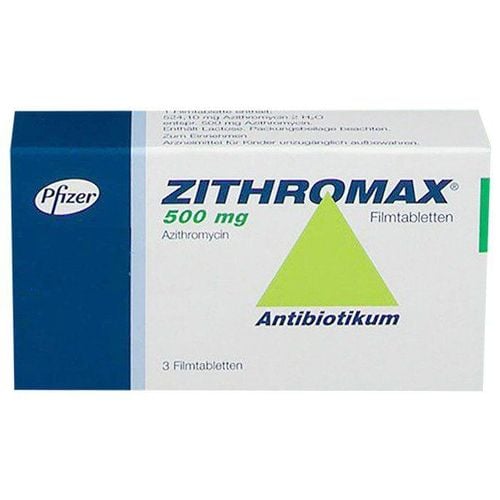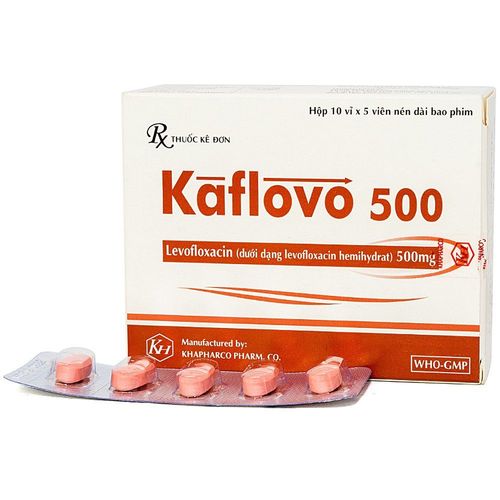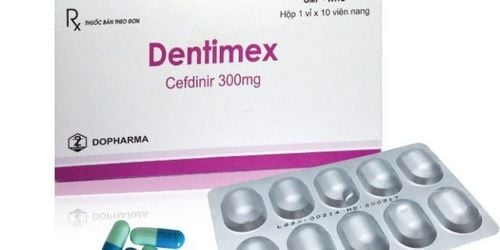This is an automatically translated article.
Gramkill is a drug indicated for the treatment of cases of pharyngitis, acute maxillary sinusitis, pneumonia, acute exacerbation of chronic bronchitis... To learn more about the composition and uses of Gramkill, see this article. The following writing will give you useful information.
1. What is Gramkill?
Gramkill is a drug containing the main active ingredient, Cefdinir, which is prepared in the form of powder for oral suspension, manufactured by Phil Inter Pharma Co., Ltd - Vietnam.Pharmaceutical name: Gramkill drug. Group of drugs: Belongs to the group of antifungal, antiviral, anti-infective, anti-parasitic drugs. Ingredients: Cefdinir. Dosage form: In the form of powder mixed with oral suspension. Content: 125mg/pack of 2.5g. Manufacturer: Phil Inter Pharma Co., Ltd - Vietnam. Registered company: Phil Inter Pharma - Vietnam Co., Ltd. Registration number: VD-23389-15.
2. Uses of the drug Gramkill
The drug is a 3rd generation Cephalosporin antibiotic, highly effective in the treatment of systemic infections. With the main pharmacological mechanism of action is to inhibit the synthesis of bacterial cell membranes and kill bacteria.
The structure of Cefdinir is stable to some Beta lactamase enzymes that bacteria secrete, on the other hand, it is also sensitive to gram-positive and gram-negative bacteria such as:
Gram-positive: S. pneumoniae (penicillin-sensitive strain). ), S.aureus (methicillin-susceptible strains) and S.pyogenes. Gram negative: H.influenza, Moraxella catarrhalis and H.parainfluenzae. The drug is indicated for the treatment of bacterial infections in the following cases:
Children and adults:
Having community-acquired pneumonia caused by H.parainfluenzae, H.influenza, S. pneumoniae (penicillin-susceptible strains), Moraxella catarrhalis (including beta-lactamase-producing strains). Suffering from acute maxillary sinusitis caused by Moraxella catarrhalis (including beta-lactamase-producing strains), H.influenza and S. pneumoniae (penicillin-susceptible strains). Amygdala disease caused by S.pyogenes, pharyngitis. For pediatric patients:
Acute otitis media caused by Moraxella catarrhalis (including beta lactamase-producing strains), H.influenzae and S. pneumoniae (penicillin-susceptible strains). Tonsillitis caused by S.pyogenes, pharyngitis . Uncomplicated inflammation of the skin and subcutaneous tissues caused by S.aureus (including beta-lactamase-producing strains) and S.pyogenes.
3. Dosage and way of taking Gramkill
3.1. Dosage of Gramkill drug Patients use the drug according to the dose prescribed by the doctor or use the following reference dose:
Children from 6 to 12 months old: Use at a dose of 14mg/kg/day, the maximum dose is 600mg/ day. In case of acute bacterial otitis media: Use at a dose of 7mg/kg x 2 times/day, continuously for 5-10 days or at a dose of 14mg/kg/time/day continuously for 10 days. In case of acute maxillary sinusitis: Use at a dose of 7mg/kg x 2 times/day or 14mg/kg/time/day, continuously for 10 days. In case of tonsillitis, pharyngitis: Use at a dose of 7mg/kg x 2 times/day, continuously for 5-10 days or at a dose of 14mg/kg/time/day, continuously for 10 days. In case of uncomplicated skin and skin structure infections: Use at a dose of 7mg/kgx 2 times/day, continuously for 10 days. For patients with renal insufficiency: Children with creatinine clearance < 30ml/min should be used at a dose of 7mg/kg/time/day, the maximum dose should not exceed 300mg. In case of patients on hemodialysis: Starting dose is 7mg/kg every 2 days in children. Since part of Cefdinir may be eliminated during hemodialysis, it is recommended that at the end of a hemodialysis session an additional dose of 7 mg/kg should be used in infants and a subsequent dose administered every other day. 2 times a day. 3.2. How to use Gramkill Gramkill is made in the form of capsules, taken orally, patients can use it with or without meals. Just peel off the pill pack, dissolve the powder with enough water and then use it to drink directly. With this dosage form, the drug is mainly used for pediatric patients and young children.
3.3. Handling of missed dose, overdose of Gramkill drug Forgotten dose:
When unfortunately missed a dose, the patient needs to take a supplement as soon as he remembers. In addition, it is advisable to skip the missed dose and take the next dose as scheduled if it is too close to the next dose. Never make up for a double dose to avoid an overdose. Overdose:
To date, there have been no clinical studies on drug overdose. When tested in rodents at a dose of 5600mg/kg, no adverse effects were observed. However, with an overdose of beta-lactam antibiotics, symptoms such as nausea, vomiting, diarrhea, epigastric pain, convulsions may appear. Therefore, patients should strictly adhere to the prescribed dose, if accidentally overdosed, and accompanied by unusual symptoms, it is necessary to immediately notify the doctor or go to the nearest medical facility for treatment. handled in a timely manner.
4. Note when using the drug Gramkill
4.1. Contraindications Gramkill Do not use Gramkill with patients who are hypersensitive to Cefdinir or other antibiotics of the Cephalosporin, Penicillin group.
4.2. Gramkill drug side effects Side effects detected through clinical studies that patients may experience include:
Common:
Vomiting, skin rash, diarrhea. Changes the results of laboratory indicators such as increasing alkaline phosphatase, lactase dehydrogenase, lymphocytes (2%), eosinophils, PMNs, platelets, proteinuria. Or reduce bicarbonate, lymphocytes (0.8%). Uncommon:
Vaginitis, vaginal thrush, fungal skin infection. Causes abdominal pain, indigestion, nausea, abnormal stools. Hyperactivity, maculopapular rash. Changing the results of laboratory indicators such as increasing Phosphorus (0.9%), white blood cells (0.7%), AST, leukocytes in urine, urine density (0.3%). Urine pH, monocytes, potassium. Or reduce Calcium, Phosphorus (0.4%), urine density (0.1%), white blood cells (0.4%), Hemoglobin. After being marketed, reports of side effects of the drug were recorded including:
Facial and laryngeal edema, shock, anaphylaxis, feeling of suffocation, toxic epidermal necrolysis, Steven Johnson syndrome. Paroxysmal hepatitis, acute hepatitis, liver failure, increased amylase, cholestatic jaundice. Erythema fissured, erythema exfoliative, varied. Colitis, acute enteritis, pseudomembranous colitis. Hemolytic anemia, thrombocytopenia, leukopenia, granulocytopenia. Coagulation disorders, bleeding, disseminated endothelium coagulation. Asthma, respiratory failure, interstitial pneumonia, drug-induced pneumonia. eosinophilic pneumonia. Allergic vasculitis. Acute renal failure, kidney disease. Intestinal obstruction, peptic ulcer, upper gastrointestinal bleeding. Chest pain, heart failure, hypertension, rhabdomyolysis, myocardial infarction, involuntary movements. If you experience any of the above symptoms during the use of Gramkill, the patient should immediately notify the doctor or medical staff for a timely solution.
4.3. Drug interactions Gramkill is likely to interact with other drugs or food when taken together, including:
Antacids containing aluminum, magnesium: Reduces Cmax, AUC and prolongs Tmax of Cefdinir, because Therefore, these two drugs should be taken at least 2 hours apart. Probenecid: Inhibits clearance of Cefdinir. Iron supplements: Supplements that contain 60mg or 10mg of iron reduce the absorption of cefdinir by 80% and 31%. If the patient needs to take an iron preparation, it should be taken at least 2 hours apart from Cefdinir. The drug may cause false-positive results when tested using the nitroprusside reagent. Therefore, the patient needs to list all the drugs and functional foods being used for the doctor to monitor, prevent interactions and have appropriate treatment if any interactions occur.
4.4. Precautions when using Gramkill Before using the drug, the patient needs to know about the history of allergy to Penicillin, Cephalosporin or other drugs. Using antibiotics can upset the balance of the intestinal microflora causing C. difficile bacteria to overgrow, thereby causing mild diarrhea or colitis, more serious even leading to death. death. Particular caution should be exercised when administering the drug to patients with a history of appendicitis. Special care should be taken when using Gramkill in pregnant women, because the safety of the drug has not been established for this group of people. Special caution should be exercised when administering the drug to a nursing woman, and should consult a physician if indicated, to weigh the risks and benefits, to avoid adverse effects on the infant. We have just learned about the composition, dosage, usage, uses of Gramkill and other important contents. To ensure safety and effectiveness, patients need to consult a doctor and use it as prescribed. Absolutely do not arbitrarily buy drugs to treat at home because there may be dangerous side effects













